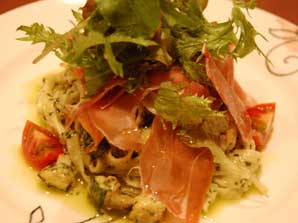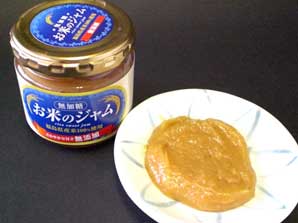Web Japan > Trends in Japan > Lifestyle > Rice-Flour Bread, Pasta, and . . . Jam!
Rice-Flour Bread, Pasta, and . . . Jam!
Japan's Traditional Staple Shows Its Versatility
Most people think of bread, cake, and pasta as products made from wheat flour, but it has recently become possible to make them from rice flour too. Rice is a food that is close to the hearts of Japanese people, and has long been used to make mochi rice cakes and other traditional Japanese sweets. But new technology that allows rice to be milled as finely as wheat has opened up an array of new possibilities for this ancient staple. Rice flour has many advantages: it is lower in calories than wheat flour, contains higher levels of protein and other nutrients, and results in a soft, springy texture that brings out the sweet taste of rice as it is chewed. Add to this the fact that it can be enjoyed even by people who suffer from gluten allergies, and it is no surprise that rice flour is growing in popularity.
Low in Calories, High in Nutrition
Broadly speaking, most of the rice grown in Japan can be divided into two categories. One is mochi rice, a sticky short-grained variety that is mashed for use in rice cakes or milled into flour as the main ingredient in dango dumplings. The other is uruchi rice: the well-known medium-grain variety. Although normally cooked in water and eaten as the staple food, uruchi rice has also traditionally been milled for use in foods such as kashiwa-mochi (rice cakes wrapped in oak leaves). But until now using this flour to bake bread has always proved problematic. The first difficulty was the size of the flour grains. Until recently, the average size of a grain of uruchi rice flour was about 180 microns, much higher than average of 50 microns for wheat flour. But new milling technology has made a finer grain of flour possible, with a granular size of between 30 and 60 microns. This new process also solves another problem with previous milling techniques, whereby the starch in the rice was broken or damaged during the milling process, so that the flour absorbed too much moisture, failed to leaven properly, and produced bread with an uneven shape.
Recent developments have revealed another advantage of rice flour over conventional wheat flour. The water content of wheat flour is around 35% to 38%, compared with 40% to 43% for rice flour. As water contains no calories, a serving of rice flour will contain fewer calories than a serving of wheat flour the same size. Rice flour also scores better on the amino acid scale, an international nutritional standard used for measuring the protein content of foods, with a score of 60 as opposed to 44 for soft types of wheat flour. And whereas bread made from wheat flour can become very tough or lose body and shape when frozen or defrosted in a microwave, rice flour bread is much more resilient and retains its shape and soft, bouncy texture even when exposed to sudden temperature changes. Rice flour bread is rapidly gaining in popularity as a lower-calorie, more nutritious alternative to wheat flour bread.
Jam Today, and Cake TooRice flour is now being used in a wide range of foods - not just in bread, but in sponge cakes, rolls, madeleines, donuts, and other kinds of Western cakes and pastries. But people can also buy the flour to bake their own bread at home. The leavening takes less time than with wheat flour, and the whole process is simple enough to be carried out in a regular kitchen oven. Rice flour pasta is also available and has been getting good reviews for its soft, springy texture. And rice flour is being used in a wide range of food products for which wheat flour was long the norm, such as okonomiyaki (thick, savory cabbage pancakes) and gyoza dumplings, and as a thickening agent in cooking.
But perhaps the most unusual application is jam. First, a special mold (Aspergillus oryzae) is added to the rice to make koji. This mix is then fermented and the starch converted into sugars, producing a sweet, nonalcoholic liquid mush. This is boiled down until it attains a creamy texture. The distinctly Japanese sweetness occurs without the addition of any extra sugar and is reminiscent of amazake, a sweet fermented drink.
The development of novel applications for rice flour is still in its early stages, and not all products rely 100% on rice flour; some use a mixture of rice flour and wheat flour. But given the many benefits of rice flour, the boom in this innovative ingredient looks set to continue. (October 2009)
- Niigata, The Rice Capital of Japan (December 26, 2007)



